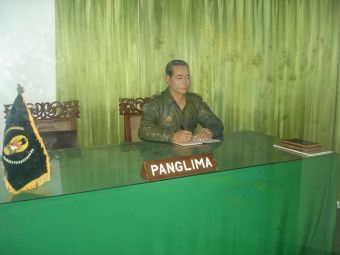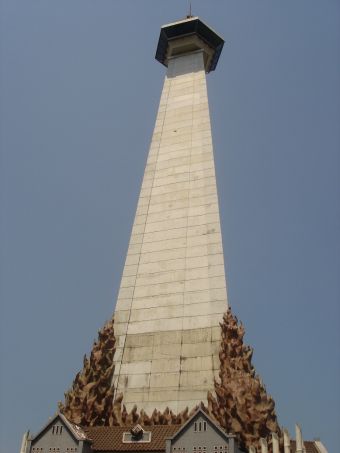Nationalism and every-day tourism
Geoff Mulherin
The monument is in the shape of a big pillarGeoff Mulherin |
Tourists visiting Makassar can hardly miss it. If they don’t see it towering above the otherwise flat, low-rise city, Monument Mandala features prominently in every guidebook and tourist brochure.
Described as a ‘landmark’ of the city, and as the place to get ‘the highest view without a helicopter’, the monument has been a major attraction for all sorts of reasons. Located centrally in Jalan Jenderal Sudirman, the monument itself is surrounded by a broad, open-air entertainment area that forms a hub of political, cultural and social performances in the city. From student protests, New Years eve disco parties and annual ‘Battle of the Bands’ music competitions – through to the start and finish for the 2007 ‘Rally of Indonesia’ car race – people are drawn to the monument. Many others come just for the history, and the view.
Perhaps predictably, seeing the ‘highest view without a helicopter’ is not always straight forward. To begin with, the only way to reach the top of the monument is via a small, airless lift that feels like it pre-dated the Dutch arrival in the archipelago. And this lift is powered by southern Sulawesi’s sometimes unreliable power supply. When I visited in late 2005 it took me three visits to reach the top of the tower. The first two coincided with blackouts, which were common at the time.
But the trip is worth it. Quite apart from the view, the visitor comes face to face with a wonderful artifact of the nationalist ideology promoted by the authoritarian New Order regime (1966-98) and its helmsman, former President Suharto. A visit provides a window to Suharto and the New Order’s version of the national project.
Identity tourism
Tourists travelling to Jakarta, whether foreign or Indonesian, will almost certainly visit at least one of the well known national monuments, statues or museums. Sukarno constructed his fair share of these, and while it remained incomplete at the time of his demise, he was responsible for the most famous – the National Monument or ‘Monas’.
A key feature of the National Monument is the series of dioramas that tell the official ‘story’ of Indonesia. Visitors to the monument absorb the story in the quiet, almost reverential expanse that coveys an aura of truth and reliability.
Like Sukarno, Suharto and his New Order regime understood the importance of official narratives of national history. Museums and monuments – sites for national parades and ceremonies, and for school group and tourist visits – provide an ideal means to tell the official story of the nation. And so throughout much of the New Order, under the guidance of the Armed Forces History Centre, museums and monuments were established to narrate the New Order’s version of the nation.
Between the mid-1960s and the 1993 opening of the Museum of Communist Treachery, Jakarta was the site of choice for much of this New Order ‘nationalist urbanism’. But just as things were coming to a close there, the decision was made to erect a new monument – modeled on the National Monument – in what was then Ujung Pandang, now Makassar.
The ‘liberation’ of West Irian
The construction of Monument Mandala began in 1994, and it was opened on 19 December 1995 – the anniversary of Sukarno’s famous Trikora speech. The monument’s main purpose was to tell the story of the ‘liberation’ of West Irian – now Papua – in the context of the broader struggle for Indonesian independence.
Around the circumference of the base of the monument is a series of reliefs that tell the nationalist story of Indonesia through scenes of key moments in that history. In most respects these reliefs are very similar to other accounts of the nationalist story portrayed elsewhere. Perhaps the only difference is the obvious presence of a Papuan face or two in the scenes of the Indonesian nationalist struggle.
Museums and monuments … provide an ideal means to tell the official story of the nation
Inside the base of the monument there are two floors each with 12 dioramas. The lower highlights moments of opposition to Dutch rule by the people of Sulawesi, while the higher tells the particular story of Papua’s liberation. Not surprisingly, key aspects of the New Order nationalist narrative are evident.
To begin with, both floors of dioramas have a decidedly military flavour to them. The broad sweep of historical moments covered in the lower level focuses almost exclusively on armed opposition to European occupation. Likewise, the collection of dioramas dealing with the liberation of West Irian is also slanted heavily towards the role of the military – and Suharto in particular – in the ‘reunification’ of the nation. In other words, the uncritical visitor to the Mandala Monument will come away with a strong message that the overthrow of Eurpoean domination, including in West Irian, was largely due to the military, and that the military and its leaders provide the ‘safe hands’ needed to keep the country together.
‘Monument to Pak Harto’
 |
Waiting for you as you exit the lift
|
However this message about the military is also overlaid with a more specific one, about Suharto himself. As the national news magazine Gatra headlined at the time of the monument’s opening, the purpose of the monument was to commemorate the president.
At the start of 1962 President Sukarno appointed Suharto as the Commander of Operation Mandala – the military operation designed to threaten the Dutch into surrendering control of West Irian. The Mandala Monument is built on the site of Suharto’s headquarters of the time, and, not surprisingly, he was invited to officially open the monument.
Suharto did, in fact, lead Operation Mandala until the territory was handed to Indonesian administration on 1 May 1963. Of course, the actual effectiveness of the military campaign, and its contribution to the final diplomatic solution that saw Indonesia gain control of West Irian, are open to question. But such questions are not asked in the official narrative. Rather, the narrative portrayed in the monument does the opposite.
To begin with, despite Indonesia’s claim to centuries-old unity with Papua, the series of dioramas on the second floor focuses heavily just on 1962, when Suharto was involved. Beginning only in 1955 with scenes concerning the establishment of a province of West Irian in 1955 in Maluku, and the establishment of the National Front for the Liberation of West Irian in 1958, the diorama series then turns to the Trikora command, and the inauguration of Suharto as Mandala Commander. This is followed by several scenes of military activities under Suharto’s command, culminating in the transfer of the territory – first to interim UN control in August 1962, and then to Indonesia on 1 May 1963. The famous (or infamous) Act of Free Choice of 1969, when carefully selected Papuan representatives voted in favour of integration into Indonesia, is almost an afterthought, shown to highlight Indonesia’s status as a law-abiding nation rather than having anything substantive to do with West Irian’s place inside or outside the country.
Suharto’s connection with the successful campaign for West Irian is then further reinforced to the dedicated tourist who wants to see ’the best view of Makassar without a helicopter.’ As you emerge from the lift to the top of the tower, you find yourself in the middle of a mock-up of Suharto’s Mandala headquaters, and confronted by a life-sized figure sitting at the general’s desk, commanding the troops on a battle map of the campaign. None-too-subtly the visitor is being asked: without Suharto, would West Irian ever have been liberated? Would Indonesia be united?
Fall of New Order
So how have the New Order’s messages at the monument fared since Suharto’s downfall in 1998? Surprisingly well it seems. At a personal level, Suharto has taken some hits to his reputation. When tourists visit the top of the monument photos of the military campaign surround them on the walls. Yet there are some curious gaps in the collection. When I asked my tour guides they told me that, soon after Suharto’s resignation, student protestors came and took down photos with Suharto in them. But that was a while ago, and Suharto’s headquarters still has a commanding presence at the top of the monument, and Suharto remains a main player in the dioramas downstairs. And there was no doubt what my tour guides thought: things were better under Suharto.
‘… the visitor is being asked - without Suharto, would Indonesia be united?’
But more importantly, the underlying nationalist story of the monument remains as alive as always. It is a story consistent with that told in other official histories, in school text books, and in much of the media across Indonesia. It is a message that the visitor will still absorb in passing, even if their only reason for coming to the monument is to attend a rock concert. Papua is part of Indonesia, and gained its independence from Dutch colonial oppression when liberated by fellow Indonesians in 1962. Indonesian independence and unity is not a gift, but is something that had to be worked for and won. ii
Geoff Mulherin (gmulherin@lawfoundation.net.au) is undertaking research into Papua’s place within the development of Indonesian nationalist narratives.












